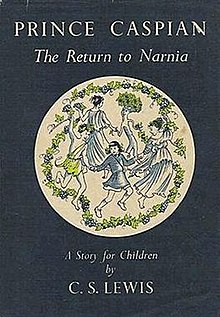|
Prince Caspian
Prince Caspian (originally published as Prince Caspian: The Return to Narnia) is a high fantasy novel for children by C. S. Lewis, published by Geoffrey Bles in 1951. It was the second published of seven novels in The Chronicles of Narnia (1950–1956), and Lewis had finished writing it in 1949, before the first book was out.[4] It is volume four in recent editions of the series, sequenced according to the internal chronology of the books. Like the others, it was illustrated by Pauline Baynes and her work has been retained in many later editions.[1][3] Prince Caspian features a "return to Narnia" by the four Pevensie children of the first novel, about a year later in England but 1300 years later in Narnia.[a] It is the only book of The Chronicles with men dominating Narnia. The talking animals and mythical beings are oppressed, and some may be endangered. The English siblings, legendary Kings and Queens of Narnia, are magically recalled, once again children, by the refugee Prince Caspian. Macmillan US published an American edition within the calendar year.[1][3] Prince Caspian has been adapted and filmed as two episodes of BBC television series in 1989 and as a feature film in 2008. Plot summaryPeter, Susan, Edmund and Lucy Pevensie are magically whisked away from a British railway station to a beach near an old and ruined castle. They determine the ruin is Cair Paravel, where they once ruled as the kings and queens of Narnia. They discover the treasure vault where Peter's sword and shield, Susan's bow and arrows, and Lucy's dagger and bottle of magical cordial are stored. Susan's horn for summoning help is missing, as she left it in the woods the day they returned to England after their prior visit to Narnia. Although only a year has passed in England, 1300 years have passed in Narnia.[a] The children rescue Trumpkin the dwarf from soldiers who are about to drown him. Trumpkin tells the children Narnia's history since their disappearance: Telmarines conquered Narnia, which is now ruled by King Miraz and his wife, Queen Prunaprismia. Miraz usurped the throne by killing his brother, King Caspian IX, the father of Prince Caspian. Miraz tolerated the rightful heir, Prince Caspian, until his own son was born. Caspian escaped from Miraz's castle with the aid of his tutor Doctor Cornelius, who schooled him in the lore of Old Narnia, and gave him Queen Susan's horn. Caspian fled into the forest but was knocked unconscious when his horse bolted. He awoke in the den of a talking badger, Trufflehunter, and two dwarfs, Nikabrik and Trumpkin, who accepted Caspian as their king. The badger and dwarves took Caspian to meet many creatures of Old Narnia. During a midnight council, Doctor Cornelius arrived to warn them of the approach of King Miraz and his army; he urged them to flee to Aslan's How in the great woods near Cair Paravel. The Telmarines followed the Narnians to the How, and after several skirmishes the Narnians appeared close to defeat. At a second war council, they decided to wind Queen Susan's horn in the hopes that it would bring help. Trumpkin and the Pevensies make their way to Caspian. The trek proves difficult, but Aslan appears to Lucy and instructs her to guide the others behind him. Aslan sends Peter, Edmund, and Trumpkin ahead to deal with treachery brewing there, and follows with Susan and Lucy. Peter, Edmund, and Trumpkin arrive and drive out or kill the creatures threatening Caspian. Peter challenges Miraz to single combat: the army of the victor in this duel would be considered the victor in the war. Miraz accepts the challenge, goaded by lords Glozelle and Sopespian. Miraz loses the combat, but Glozelle and Sopespian declare that the Narnians have cheated. The lords command the Telmarine army to attack, and in the commotion that follows, Glozelle stabs Miraz in the back. Aslan, accompanied by Lucy and Susan, summons the gods Bacchus and Silenus, and with their help brings the woods to life. The gods and awakened trees turn the tide of battle and send the Telmarines fleeing. Discovering themselves trapped at the Great River, where their bridge has been destroyed by Bacchus, the Telmarines surrender. Aslan gives the Telmarines a choice of staying in Narnia under Caspian or returning to Earth, their original home. After one volunteer disappears through the magic door created by Aslan, the Pevensies go through to reassure the other Telmarines, though Peter and Susan reveal to Edmund and Lucy that they are too old to return to Narnia. The Pevensies find themselves back at the railway station. Characters
ThemesThe two major themes of the story are courage and chivalry and, as Lewis himself said in a letter to an American girl, "the restoration of the true religion after a corruption".[5] The Telmarine conquest of Narnia, as depicted in the book, is in many ways similar to the historical Norman Conquest of England. Though there is no precise parallel in actual English history to the specific events of this book, the end result – "Old Narnians" and Telmarines becoming a single people and living together in harmony – is similar to the historical process of Saxons and Normans eventually fusing into a single English people. AdaptationsThe BBC adapted Prince Caspian in two episodes of the 1989 series of The Chronicles of Narnia. The second in the series of films from Walt Disney Pictures and Walden Media, titled The Chronicles of Narnia: Prince Caspian, was released in the US on 16 May 2008. The UK release date was 26 June 2008. The book was the inspiration for a song of the same name on the Phish album Billy Breathes.[6] The script for a stage adaptation was written by Erina Caradus and first performed in 2007.[7] See alsoNotes
References
Sources
External linksWikiquote has quotations related to Prince Caspian.
|
||||||||||||||||||||||||||||||||||||
